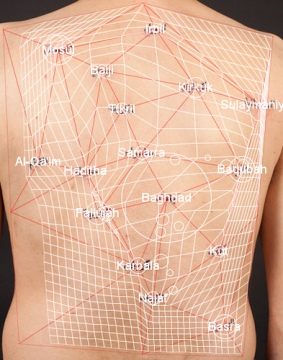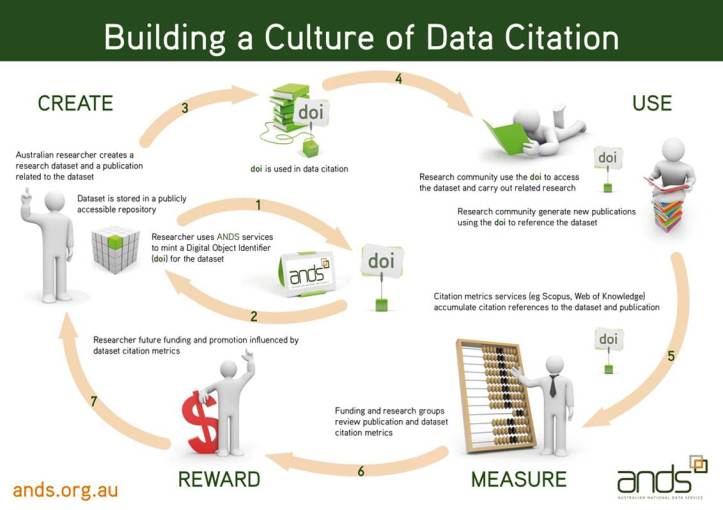 Margaret Henty is Senior Policy Advisor with the Australian National Data Service (ANDS).
Margaret Henty is Senior Policy Advisor with the Australian National Data Service (ANDS).
In practice, this means looking at all of those legal and policy issues which have an impact on data sharing and use, such as copyright, licensing, ethics, Gov 2.0, etc and keeping an eye on developments overseas.
ANDS is building the Australian Research Data Commons: a cohesive collection of research resources from all research institutions, to make better use of Australia’s research data outputs.
Tattoos are big business at the moment. People everywhere are adorning themselves with something to help make them feel a little more individual, something which belongs to them and no-one else.

The data you create as part of your research can have its own tattoo, too. It’s called a Digital Object Identifier (DOI). You’re probably familiar with the concept of the DOI being attached to your journal articles. Now you can also attach them to your data. It is something like a tattoo for your body, an electronic tag for your dog, or an ISBN for your book.
You should tattoo your data for the same reasons you tattoo your body (and for some bonus reasons, too):
- It makes the data uniquely identifiable.
- You will always be identified as the creator of the data.
- Having a data tattoo means that your data can always be located with a simple web search.
- It means your data can be cited, whether by someone else or by you and any data citations can be added to journal citations.
- It means that usage of your data can be followed as others use and cite your data.
“So what?” I hear you ask. Well, changes are afoot in the research world, the kinds of changes which may well have an effect on the way reward structures in academe operate. Currently, merit in the academic world is recognised by virtue of research publications in the form of books or journal articles (or in some cases, creative works).
Other types of research output have barely, if ever, been recognised. This applies especially to research data, something which is routinely collected in the course of research and that forms the basis of all those publications. Is it valuable? Yes, it is, and not just to you.
If your research data is accessible to others, once you have finished with it, other researchers might be able to combine it with their own results, re-analyse it for some purpose you didn’t think of, or use it within some other discipline.
Enter the DOI, the key to ensuring that your data can be cited and its usage tracked, a simple tool which can – and probably will at some point – be used for research evaluation purposes.
Interest has been growing internationally about the whole issue of data citation for a couple of years. There are now several organisations which provide DOIs solely for data. The Australian National Data Service (ANDS) mints DOIs in Australia, working as a member of DataCite, a not-for profit organisation formed in 2009 with aims to create easier access to research data and to improve the status of research data as a contribution to the scholarly record.
Most researchers will be familiar with Web of Knowledge (ThomsonReuters, via registration) and Scopus (Elsevier, via registration). These products currently track journal citations only, but that is about to change. Both publishers are now investigating the addition of data to their businesses, and ThomsonReuters already has its toes in the water with its new Data Citation Index. It may take a year or two until it has sufficient content to allow for the production of usage metrics, but they are on their way.
There is a cycle going on here which is well illustrated in the figure below. The cycle goes something like this.

- A researcher – let’s call him Ben – creates some data and publishes the findings of the research project in a journal. At the same time, he makes sure that the data is stored in a publicly accessible data repository, which may be in his university or elsewhere.
- He (or his friendly data manager) collects a DOI for the data through ANDS. Unlike a real tattoo, this is not painful.
- He uses this DOI when citing his data, and is pleased to find that other researchers discover and use the data.
- They, in turn, cite Ben’s data in their future research.
- Data usage is tracked in Web of Knowledge or Scopus.
- This information can be used when his research is evaluated and when decisions are made about funding future research.
- So, he uses his new funding to create additional data and the cycle starts again.
You can already find datasets with DOIs attached. In the following example, the data record in Research Data Australia includes both the data DOI and a reference to a publication related to it. Find one and you have the other:
- Hanigan, Ivan. (2012 ) Monthly drought data for Australia 1890-2008 using the Hutchinson Drought Index. Australian Data Archive. doi: 10.4225/13/50BBFD7E6727A
- Hanigan, IC, Butler, CD, Kokic, PN, Hutchinson, MF. Suicide and Drought in New South Wales, Australia, 1970-2007. Proceedings of the National Academy of Science USA 2012, vol. 109 no. 35 13950-13955, doi: 10.1073/pnas.1112965109
There is lots of discussion around at the moment about how to cite data and, at this stage, no real standard has emerged. The example above, however, is quite adequate for the purpose of discovering and uniquely identifying the data. You can find out more by visiting the ANDS website.
So, you can see that there are significant benefits to you in making your research data available to others when you have finished your research.
It’s likely, too, that research funding will be made conditional on data being disseminated following a research project. Yes, it’s true that not all data can be shared, but most of it can. Get your data tattooed now, and be ahead of the trend!
Thank you for submitting this article. It gives a clear and concise picture of the benefits of DOI application and use.
LikeLike
Interesting! Do you know whether other countries have also made it possible to mint DOIs for your data? And are there any costs involved with minting a DOI?
LikeLike
Yes, other countries are making DOIs for data available – Germany, France, Britain, Canada, USA and more. No, there is no cost for a DOI, at least in Australia where ANDS is bearing the cost. Contact me directly and I’ll find out who your local ANDS contact person is and they can arrange it for you.
LikeLike
[…] The Open Access movement around research publications is gathering momentum. Increasingly, researchers are also making their research data available in open access repositories. Attaching persistent digital identifiers to your data (DOIs) enables the data to be cited by those who use it. It can also help to link your publications with your research data. Contact us at research-data at unimelb.edu.au if you would like to learn more about Data Citation. To read some more about all this go to: http://theresearchwhisperer.wordpress.co… […]
LikeLike
Using a Data citation as a tattoo It will makes the data uniquely identifiable and you are identified as a creator of the data.
LikeLike